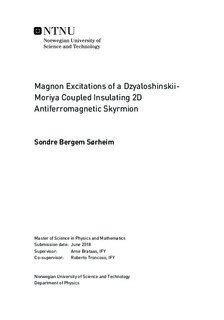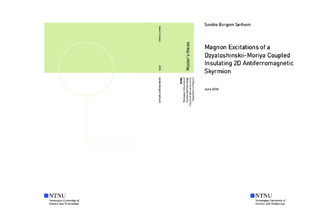| dc.description.abstract | Motivated by recent experimental progress in realizing novel antiferromagnetic phases with state-of-the-art characteristics for memory storage and information processing, we study the magnon excitation spectra and eigenmodes around the antiferromagnetic skyrmion. In the micromagnetic limit of an insulating nearest-neighbour spin coupled two-sublattice antiferromagnet, we derive from Hamilton's principle a new set of coupled Schrödinger-like equations for perpendicularly excited magnons with respect to an inhomogeneous chiral texture.
In the limit of a homogeneous antiferromagnetic ground state, the impact of various interaction mechanisms on the dispersion relation is discussed. A nonzero external magnetic field lifts the degeneracy of right-circularly and left-circularly polarized modes, while the asymmetric Dzyaloshinskii-Moriya interaction shifts the continuous spectra in momentum space along particular directions dictated by the polarization degree of freedom.
For the chiral antiferromagnetic skyrmion, the Hamiltonian matrix subject to various pinning strengths of the texture-induced potential is numerically diagonalized for azimuthally symmetric modes. We find that the out-of- and in-plane, with respect to the skyrmion basal plane, excitation modes decouple. The presence of the Dzyaloshinskii-Moriya coupling and the localized feature of the skyrmion make Goldstone, bound and unbound modes emerge for both in-plane and out-of-plane magnons. The Goldstone modes can be interpreted as a collective excitation of the entire skyrmion, or as equally likely exponentially damped evanescent or growing resonant modes for which further consideration by for instance kinetic theory and Landau damping is necessary to collapse the modes onto either solution. We find that the relative strength of the intrinsic coupling mechanisms is decisive for the magnon states that appear. | |

